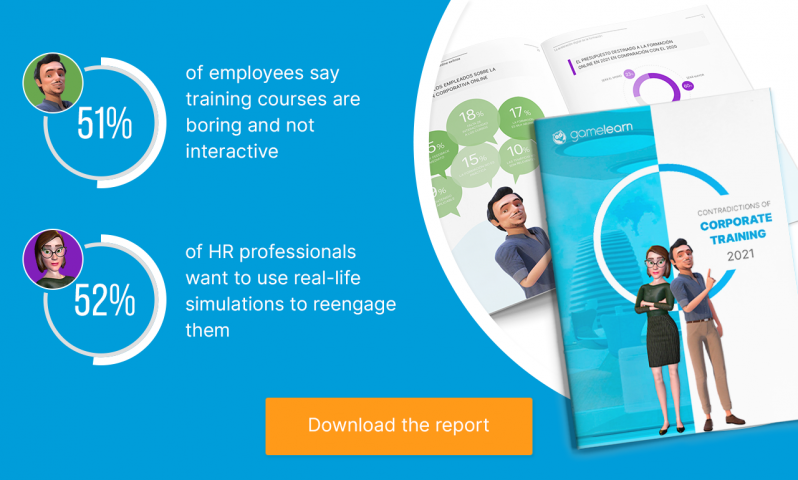2020 has been a year of dramatic changes brought on by the Covid-19 pandemic. Remote work has suddenly become the new standard and companies have had to scramble to get all their processes online. With everybody working from home, HR and L&D professionals have turned to e-learning to get their corporate training digitized and online, but are they doing it right? Do all these courses and webinars really work? Or could we take it a step further?
With this in mind, Gamelearn launched a survey in which more than 1,500 HR professionals and employees across the US and Europe participated. We gained invaluable insights into the kinds of e-learning solutions companies are offering their employees, comparing those findings with the kind of training employees actually want.
The online corporate training we want vs. what we get
With the data gathered from our survey, we can see most companies’ online training is currently limited to traditional formats. The majority of HR professionals said they have used text documents (71%) and videos (62%) in their online training, as well as tests (48%) and presentations (47%). These kinds of formats lack the type of interaction employees claimed they wanted to receive in their corporate training courses last year.
Employees’ most popular choices for online learning were virtual reality (48%), augmented reality (46%), and video games (45%). These formats rely on state-of-the-art technology to generate high levels of engagement, a stark contrast to the traditional texts, videos, and presentations that Human Resources departments are currently providing.
As the evidence reveals, the e-learning formats HR professionals have been using (either created in-house or acquired through external providers) are not in line with employee expectations, nor are they most conducive to learning. In fact, they’re the exact opposite. The top three training course formats desired by employees were the least used methods implemented by HR professionals in 2020. It’s worth mentioning, however, that HR professionals in organizations also wanted to use the same innovative formats as employees, but found that a lack of resources, technical knowledge, and limited options on offer from external suppliers, made it impossible for them to provide it.
This disconnect between what employees want and what they are receiving can lead to a lack of engagement and motivation, which negatively impacts performance and, ultimately, the business’s bottom line. Employee training that isn’t engaging is just as bad as having no training at all. It doesn’t matter how useful the information is. If the format used to transmit that information isn’t captivating and practical, there’s no use in teaching it. Why? Because employees won’t be paying attention.
It’s clear that the status quo of corporate training isn’t aligned with how employees best learn skills. With everything being redefined by the “new normal”, there’s no better time than the present to revamp corporate training strategies. So why not provide your clients with the solution everyone wants but organizations just don’t have the know-how to produce? Let’s take a closer look at the online learning formats employees actually want.
Can we give our clients what their employees really want?
Virtual reality (VR) and augmented reality (AR), may sound a bit futuristic to some, but the future is already here. These technologies have been used in a variety of industries for some years to train employees. There are many potential benefits to using VR (or AR) in corporate training, as it allows employees to learn through practical experience and get personalized feedback, which can increase engagement and knowledge retention.
However, the cost of acquiring and implementing VR and AR technology is quite high. These technologies require significant investment and certain infrastructure to guarantee successful adoption across an organization. Moreover, they are difficult to scale, given you need to buy hardware for each employee. Is there a better solution that’s more scalable and fits within budget requirements? Two words: video games. And this happens to be in line with what employees want.
A solution for everyone
Why did employees claim to want video games for corporate training? Because they want to be engaged when learning skills. What they really need is a new methodology, and this is where game-based learning comes into play. Game-based learning provides quality content that’s applicable to the job, in a fun format. It uses elements of gamification such as rankings and competition to keep employees engaged. Additionally, it employs experiential learning and simulations, which enable employees to learn by doing, all while remaining in a safe environment.
In essence, the video games employees want are the way to put the theory of game-based learning into practice. The video game is the final product—and a surefire way for professionals to meet the needs of the organization and the expectations of employees.
While you can get similar results with VR and AR, as mentioned above, they simply aren’t practical at the moment. Video games are the best of both worlds. They provide the same benefits VR and AR do—engagement, practicality, and retention, but at a fraction of the cost. They’re scalable, budget-friendly, and provide measurable results.
Game-based learning is, according to experts, the most effective learning technology of the 21st century. So, what are you waiting for? Take your corporate training to the next level and give your clients what they, and their employees, really want. The results speak for themselves.


